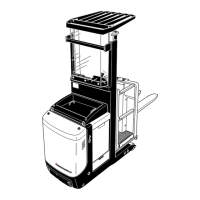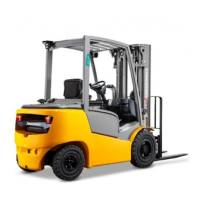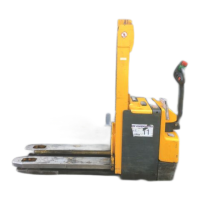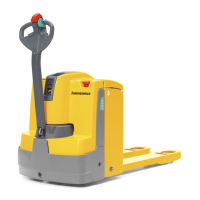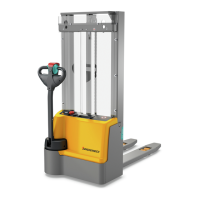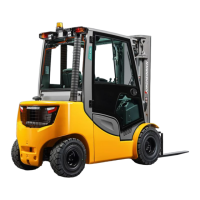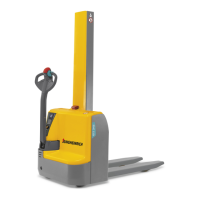E 7
1298.GB
4 Putting vehicle in operation
f
Before starting or operating the truck, or before lifting any loads, the driver has to
make sure that nobody is within the danger area.
Checks and actions before routine start-up
– Perform a visual check of the entire truck for obvious damages or leakages.
– Check the battery attachment and the cable connections for damages and tight se-
at.
– Check the battery connector for tight seat.
– Check the overhead guard for damages.
– Check the load lifting device for obvious damages such as cracks, bent or heavily
abrased fork.
– Check the load bearing wheels for damages.
– Check whether the load chains are tightened evenly.
– Check whether all safety measures are in good condition and working properly.
– In case of a rail guide, check idler pulleys on true running and damages.
– Check brakes for correct function.
f
Only one person is allowed in the driver’s cabin!
Provide operatability
f
When closing or opening the cabin lock
between barrier and frame, take care not
to pinch your fingers.
– Fully close the safety barriers on both
sides.
– Insert key into the key switch (3) and
turn clockwise.
– Turn the Emergency-OFF switch (2) to
unlock it.
– Check the warning signal (horn) for
correct function.
– Check the service brake and parking
brake for correct function.
– Carry out reference run of the lifting
mast to adjust height indication and
maximum movements.
f
If during start-up procedure any unwan-
ted driving or lifting movements are ob-
served, immediately operate the
Emergency-OFF switch.
3
E 7
1298.GB
4 Putting vehicle in operation
f
Before starting or operating the truck, or before lifting any loads, the driver has to
make sure that nobody is within the danger area.
Checks and actions before routine start-up
– Perform a visual check of the entire truck for obvious damages or leakages.
– Check the battery attachment and the cable connections for damages and tight se-
at.
– Check the battery connector for tight seat.
– Check the overhead guard for damages.
– Check the load lifting device for obvious damages such as cracks, bent or heavily
abrased fork.
– Check the load bearing wheels for damages.
– Check whether the load chains are tightened evenly.
– Check whether all safety measures are in good condition and working properly.
– In case of a rail guide, check idler pulleys on true running and damages.
– Check brakes for correct function.
f
Only one person is allowed in the driver’s cabin!
Provide operatability
f
When closing or opening the cabin lock
between barrier and frame, take care not
to pinch your fingers.
– Fully close the safety barriers on both
sides.
– Insert key into the key switch (3) and
turn clockwise.
– Turn the Emergency-OFF switch (2) to
unlock it.
– Check the warning signal (horn) for
correct function.
– Check the service brake and parking
brake for correct function.
– Carry out reference run of the lifting
mast to adjust height indication and
maximum movements.
f
If during start-up procedure any unwan-
ted driving or lifting movements are ob-
served, immediately operate the
Emergency-OFF switch.
3

